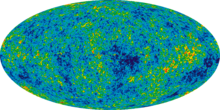
De Sitter universe

A de Sitter universe is a cosmological solution to the Einstein field equations of general relativity, named after Willem de Sitter. It models the universe as spatially flat and neglects ordinary matter, so the dynamics of the universe are dominated by the cosmological constant, thought to correspond to dark energy in our universe or the inflaton field in the early universe. According to the models of inflation and current observations of the accelerating universe, the concordance models of physical cosmology are converging on a consistent model where our universe was best described as a de Sitter universe at about a time t = 10 − 33 {displaystyle t=10^{-33}} seconds after the fiducial Big Bang singularity, and far into the future. A de Sitter universe is a cosmological solution to the Einstein field equations of general relativity, named after Willem de Sitter. It models the universe as spatially flat and neglects ordinary matter, so the dynamics of the universe are dominated by the cosmological constant, thought to correspond to dark energy in our universe or the inflaton field in the early universe. According to the models of inflation and current observations of the accelerating universe, the concordance models of physical cosmology are converging on a consistent model where our universe was best described as a de Sitter universe at about a time t = 10 − 33 {displaystyle t=10^{-33}} seconds after the fiducial Big Bang singularity, and far into the future. A de Sitter universe has no ordinary matter content but with a positive cosmological constant ( Λ {displaystyle Lambda } ) that sets the expansion rate, H {displaystyle H} . A larger cosmological constant leads to a larger expansion rate:
